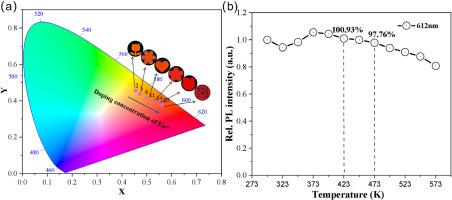Tunable luminescent color and anti-thermal quenching of Dy3+ or/and Eu3+ doping in Sc2(WO4)3 phosphors for white light-emitting diode applications
IF 3.5
3区 化学
Q2 CHEMISTRY, INORGANIC & NUCLEAR
引用次数: 0
Abstract
To address issues such as poor thermal stability and tunable luminescent colors of conventional phosphors for solid-state lighting applications, a series of Sc2(WO4)3: Ln3+ (Ln = Dy or/and Eu) phosphors were synthesized via a high-temperature solid-state method, and their luminescent behaviors were investigated in detail. Under 350 nm excitation, the Sc2(WO4)3:xDy3+ phosphor exhibits blue (487 nm), yellow (576 nm) and red (666 nm) emission peaks, and the optimal doping concentration of Dy3+ is 4 %. In the Sc2(WO4)3:4 %Dy3+/yEu3+ phosphor, energy transfer is revealed through the analysis of the spectral overlap of Dy3+ and Eu3+, thereby achieving tunable luminescence from orange to red. Combined with the results of FT-IR and TG analyses, the Sc2(WO4)3:4 %Dy3+/2 %Eu3+ phosphor exhibits non-hygroscopic properties. Furthermore, the Sc2(WO4)3:4 %Dy3+ and Sc2(WO4)3:4 %Dy3+/2 %Eu3+ phosphors exhibit excellent thermal stability (At 423 K, the intensity of the orange (576 nm) and red (612 nm) light both exceed 95 % of that of room temperature). In addition, the anti-thermal quenching mechanism is systematically investigated through temperature-dependent PL dynamics. This is attributed to combined action for the stabilized energy transfer process from Dy3+ to Eu3+ and the suppression of non-radiative transitions with the increase of temperature. These findings demonstrate that Sc2(WO4)3:Dy3+/Eu3+ phosphors with excellent thermal stability and tunable luminescence can be used as potential applications in WLED fields.

白色发光二极管用Sc2(WO4)3荧光粉中Dy3+或/和Eu3+掺杂的可调发光颜色和抗热猝灭性
为解决传统固态照明荧光粉热稳定性差、发光颜色可调等问题,采用高温固态法制备了一系列Sc2(WO4)3: Ln3+ (Ln = Dy或/和Eu)荧光粉,并对其发光行为进行了详细研究。在350 nm激发下,Sc2(WO4)3:xDy3+荧光粉呈现蓝色(487 nm)、黄色(576 nm)和红色(666 nm)发射峰,Dy3+的最佳掺杂浓度为4%。在Sc2(WO4)3:4 %Dy3+/yEu3+荧光粉中,通过分析Dy3+和Eu3+的光谱重叠,揭示了能量转移,从而实现了从橙色到红色的可调发光。结合FT-IR和TG分析结果,表明Sc2(WO4)3:4 %Dy3+/ 2% Eu3+荧光粉具有非吸湿性。此外,Sc2(WO4)3:4 %Dy3+和Sc2(WO4)3:4 %Dy3+/ 2% Eu3+荧光粉表现出优异的热稳定性(在423 K时,橙色光(576 nm)和红色光(612 nm)的强度均超过室温的95%)。此外,通过温度相关的PL动力学系统地研究了抗热猝灭机制。这归因于从Dy3+到Eu3+的稳定能量传递过程和随温度升高而抑制非辐射跃迁的共同作用。这些研究结果表明,Sc2(WO4)3:Dy3+/Eu3+荧光粉具有良好的热稳定性和可调谐的发光特性,在WLED领域具有潜在的应用前景。
本文章由计算机程序翻译,如有差异,请以英文原文为准。
求助全文
约1分钟内获得全文
求助全文
来源期刊

Journal of Solid State Chemistry
化学-无机化学与核化学
CiteScore
6.00
自引率
9.10%
发文量
848
审稿时长
25 days
期刊介绍:
Covering major developments in the field of solid state chemistry and related areas such as ceramics and amorphous materials, the Journal of Solid State Chemistry features studies of chemical, structural, thermodynamic, electronic, magnetic, and optical properties and processes in solids.
 求助内容:
求助内容: 应助结果提醒方式:
应助结果提醒方式:


